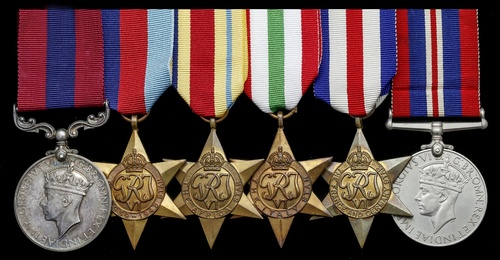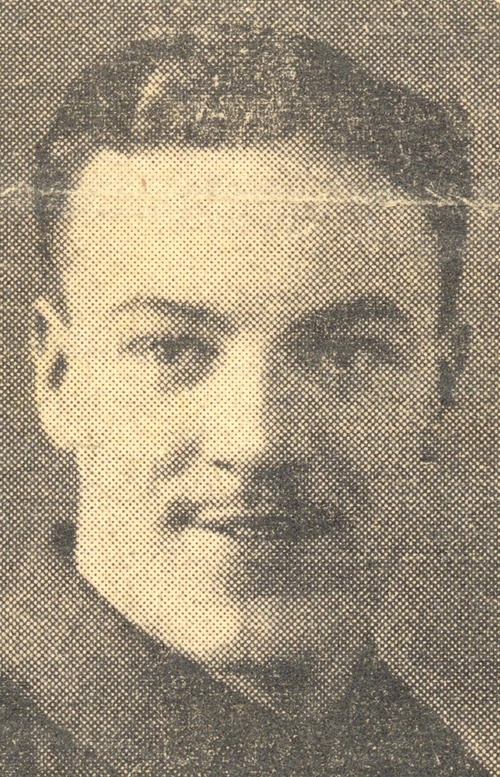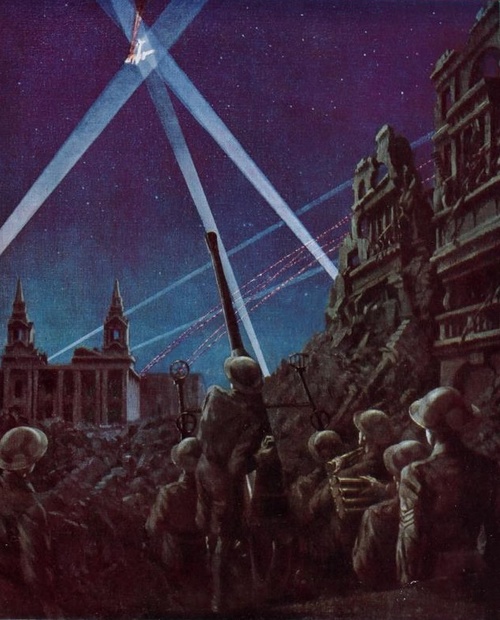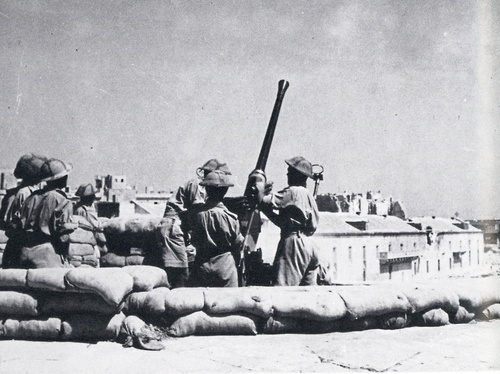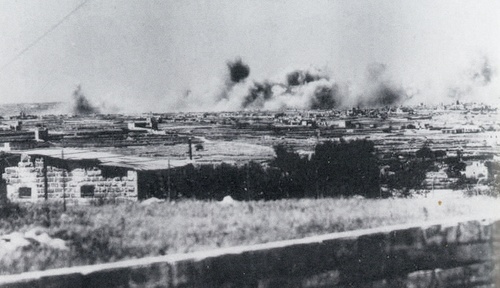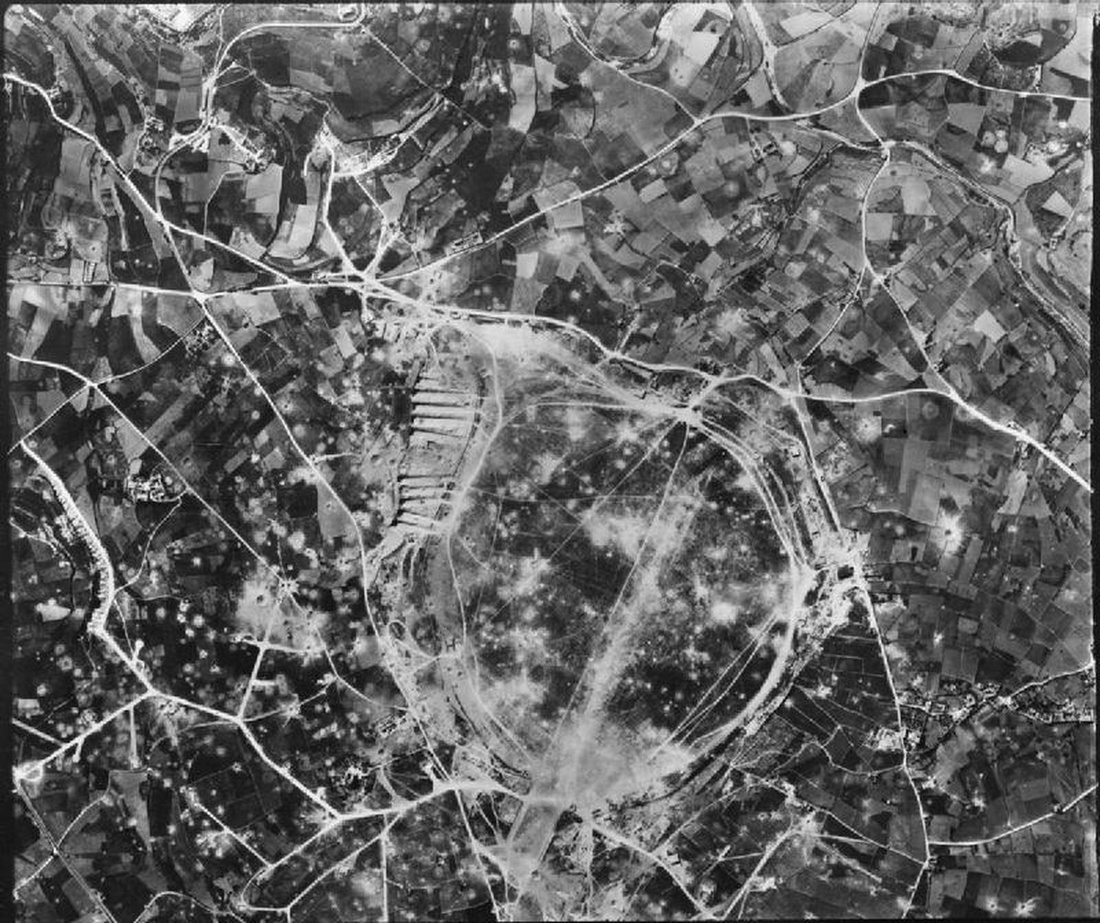Auction: 17002 - Orders, Decorations and Medals
Lot: 376
'I wish to express my greatest admiration of your officers and men for the excellent way in which they are defending this island. I have been out when raids have been at their height, and I have seen your gun crews engage the enemy regardless of their own safety. For sheer guts, determination and hard work, your men can never be beaten. You must feel very proud of them.
The attack at Ta Kali was directed quite as much against your gun positions as against the aerodrome. I was in the target area, so I am not retailing hearsay evidence. I wish to express my warmest admiration and appreciation of those gun crews for their magnificent work. It was a scene I shall never forget. Although the bombs were directed at the gun positions and there was immense noise, smoke and dust, your gun crews engaged each aircraft one by one. No wild firing. Just waiting for each bird and then within range letting him have it. A great sight, and a performance of which you may feel justly proud.
Then the attacks on the Grand Harbour with the magnificent barrage and light A.A. going for each bird. It takes terrific courage. Your officers and men have it in spare. Everyone in the Valetta area has the profoundest admiration for your work and courage. It is superlative and epic. Very well done - all of you. Magnificent.'
A Royal Artillery Special Order of the Day, dated 28 March 1942, quotes Malta's A.O.C., Air Vice-Marshal Hugh Pughe Lloyd.
An extremely rare and quite outstanding defence of Malta D.C.M. group of six awarded to Battery Sergeant-Major E. B. 'Ted' Bailey, Royal Artillery, who commanded a Bofors gun team in 32nd Light Anti-Aircraft (L.A.A.) Regiment at Ta Kali airfield and in Grand Harbour, Valetta: at the height of the famous siege in March-April 1942, an artillery officer suggested the B.B.C. scale down its endless bulletins by simply stating, 'During last month, Malta had six all clears, one of which lasted for twenty-five minutes'
Unlike other military personnel who were permitted to seek shelter, the gunners of the Royal Artillery and Royal Malta Artillery remained fully exposed to enemy attack. An indication of their steely resolve is to be found in all manner of startling statistics, among them the expenditure of 43,260 rounds by the island's L.A.A. batteries in March 1942 alone and a gunner casualty return of 149 killed and 290 wounded by the end of the following month
Even a Berlin radio communiqué was moved to announce 'Malta's Anti-Aircraft Artillery must be counted among Tommy's very best'. Italy's Foreign Minister, Count Ciano, went one step further and concluded that airborne or seaborne invasion was impossible owing to 'the unimpaired efficiency of the anti-aircraft and coast defences of Malta'
Distinguished Conduct Medal, G.VI.R. (967465 Sjt. E. B. Bailey, R.A.); 1939-45 Star; Africa Star; Italy Star; France and Germany Star; War Medal 1939-45, together with the recipient's enamelled D.C.M. League lapel badge, extremely fine (7)
D.C.M. London Gazette 13 August 1942. The original recommendation states:
'This N.C.O. is Detachment Commander of a Bofors gun on Ta Kali aerodrome. On 12 March 1942, during a raid on Ta Kali, a number of bombs fell in this position, demolishing the billet and destroying ammunition. He kept his gun firing against enemy bombers and displayed great coolness.
On 20 March 1942, during a very heavy raid in the morning, his gun position was again bombed while he was engaging planes coming in from another direction. Heavy bombs again fell within 20 yards of his gun but by his example, the detachment remained steady and continued engaging until a further stick of bombs fell close to the gun putting it out of action as a result of bomb splinters. One man was wounded and several of the detachment received slight injuries from blast.
Another gun was put in place early the following morning and in the first engagement with Me. 109s, Sergeant Bailey's detachment successfully engaged - three hits were obtained and a plane was claimed to have been destroyed. Subsequent reports prove that the plane fell into the sea during this engagement.
Sergeant Bailey's inspiring leadership and devotion to duty always - especially on the above occasions during these very heavy attacks - have been most marked and have contributed largely to the detachment's fighting spirit.'
Edward Bell Bailey, who was born in March 1917, enlisted in the Royal Artillery in March 1940. Having been advanced to Bombardier in December 1940 and to Sergeant in April 1941, he was embarked for Malta in 32nd Light Anti-Aircraft (L.A.A.) Regiment, R.A.
A Bofors unit of 7th (L.A.A.) Brigade, Bailey's unit was equipped with three batteries under the command of Lieutenant-Colonel H. J. King, batteries that were in constant action throughout the siege in 1942-43. Such was the strain - and high cost - imposed on Malta's gunners that the C.R.A., Major-General C. T. Beckett, later observed in The Royal Artillery Commemoration Book 1939-1945, 'if we sent someone on a course to Egypt, we never saw him again.'
As revealed in James Holland's Fortress Malta - An Island Under Siege 1940-43, via the input of one of Bailey's comrades, 32nd L.A.A. Regiment undertook tours of duty at Grand Harbour, Valetta, in addition to the defence of Ta Kali aerodrome. Both were primary targets for the fighters and bombers of the Luftwaffe and Regia Aeronautica who, in overwhelming numbers and at high cost, pursued a ruthless and relentless campaign to bludgeon the island into submission: that they failed in that quest was largely due to Malta's gunners.
As early as January 1942, enemy raids were averaging five by day and four by night. In one three-day period in February, Bailey and his comrades manned their guns without respite for 66 hours and one 'alert' lasted for nearly 14 hours. What followed in March defied all previous statistics, Malta's L.A.A. batteries expending an astonishing total of 43, 260 rounds: some of those rounds - not a few of them - were expended by Bailey's battery in the defence of Ta Kali aerodrome.
In respect of Ta Kali and the dates referred to in Bailey's D.C.M. recommendation, three references offer compelling evidence of extraordinary resilience under fire: Malta - The Spitfire Year, 1942, by Christopher Shores and Brian Cull; Routledge's History of the Royal Regiment of Artillery - Anti-Aircraft Artillery 1941-55, and H.M.S.O's The Air Battle of Malta - The Official Account of the R.A.F. in Malta, June 1940 to November 1942. By way of introduction, the latter pays tribute to Ta Kali's gunners in vivid terms:
'The guns were belting out rounds like nothing on earth; tracers filled the sky, and if things weren't so serious one could have called it a lovely sight. The din was terrific and Ta Kali seemed ablaze from end to end. The lads would shout that some gun or other had stopped firing, the crew had been knocked out; but no, they started again pushing up rounds harder than ever. The Jerry seemed to be under orders to finish the place and, hell, he tried his best.'
The same source describes how gunners were singled out for special attention:
'The weight of these attacks was particularly severe on the gun positions surrounding the airfield. At first, the enemy made the actual airfield itself the main objective. Gun positions suffered from badly aimed bombs and from those released too early or too late, but very soon his main objective became the fringes of the airfield where the aircraft were lying. Combined with this, he made deliberate attacks on the anti-aircraft positions. These suffered severely as they could not be moved out too far lest the airfield runways became bereft of protection.'
Of this special attention, Routledge states:
'Whilst the Ju. 88s rarely flew low enough to offer realistic targets for 40mm. [Bofors] fire, their escorting fighters, mainly 109s, either dived to rake airfields and gun positions with cannon and machine-gun fire, or stood off from the initial onslaught to pin-point gun positions opening fire, and then swooped on them from the rear.'
The morning of Thursday 12 March 1942 - the first date referred to in Bailey's D.C.M. recommendation - commenced with a strike on the aerodrome by four Ju. 88s of 11/KG 77, in which seven Hurricanes were damaged; the afternoon witnessed another raid by three Ju. 88s which left a Hurricane, a Spitfire a Blenheim damaged, and four airmen wounded. From Bailey's perspective, however, it was the events of 20 March that likely left an indelible memory: Kesselring ordered a major strike on Ta Kali by more than 60 Ju. 88s, escorted by Me. 110s and 109s. Malta - The Spitfire Year, 1942 takes up the story:
'Ta Kali was rendered unserviceable following this onslaught, when in excess of 114 tons of bombs were directed at the airfield. German crews reported good accuracy, with explosions seen among the quarters, hangars and aircraft blast pens.'
They might have added that equal accuracy was attained in respect of the defending gun batteries, for Bailey's gun was put out of action and several of his men wounded. As noted by Routledge, some of the Ju. 88s were armed with special 'Panther' bombs, armed with cordite candles to promote velocity and penetration, and others, 'rockets, delayed-action bombs and anti-personnel devices'.
A new gun having been installed in Bailey's position at Ta Kali by the following morning, he and his gunners were quickly back in action:
'The Luftwaffe's all-out assault on Ta Kali was repeated during the morning [of the 21st], a total of 106 Ju. 88s, plus one Bf. 110 for observation duties, escorted by large numbers of Bf. 109s - over 200 aircraft in all - appearing between 0845 and 1015. The airfield was again heavily cratered (182 tons of bombs being released here), and many delayed-action bombs were dropped in the first example of 'carpet-bombing' the Island had experienced. Despite a complete lack of opposition in the air, only two persons were killed and seven injured on this occasion, the A.A. claiming one bomber shot down and two damaged' (Malta - The Spitfire Year, 1942, refers).
It was Bailey's gun that claimed the enemy bomber shot down.
The Luftwaffe returned to Ta Kali in the afternoon, 70 Ju. 88s and a large fighter escort attacking in waves from 6,000 feet and, in some instances, even lower. Some of the aircraft dropped two large bombs fastened together by a stout chain: the airfield was so badly damaged that our returning fighter pilots likened it to the aftermath of a volcanic eruption.
Bailey was recommended for the D.C.M. but the battle was far from over. Of ensuing events in April, H.M.S.O's Official Account of the R.A.F. in Malta, June 1940 to November 1942 states:
'On average there were 170 enemy bombers over every day, Ju. 88s and Ju. 87s coming in waves of 12 to 15 at a few minutes' interval … each raid usually lasted about one hour and the total time under raids during the month came to 12 days, 10 hours and 20 minutes … the Anti-Aircraft Artillery for a time had the battle to themselves. They destroyed 102 enemy aircraft in the month, their best achievement. Thirty of these fell to them during one week ended 8 April. In the course of that week they achieved their record of ammunition expenditure. In one day an average of 69 rounds was fired from every Heavy Anti-Aircraft gun and 56 rounds from every Bofors gun.'
Small wonder that one Royal Artillery officer suggested to the B.B.C. that it cut down the scale of its bulletins by simply stating: 'During last month, Malta had six all clears, one of which lasted for twenty-five minutes.' Even Berlin radio was heard to announce that 'Malta's Anti-Aircraft Artillery must be counted amongst Tommy's very best.' Italy's Foreign Minister, Count Ciano, Mussolini's son-in-law, went one step further, declaring that an airborne of seaborne invasion was off the agenda, owing to 'the unimpaired efficiency of the anti-aircraft and coastal defences of Malta.'
Bailey subsequently served in 55th L.A.A. Regiment and, having been advanced to Battery Sergeant-Major in April 1944, fought in the Italy and North-West Europe campaigns. He was demobbed in March 1946 and settled in Middlesbrough, Yorkshire.
Sold with a large quantity of original documentation, including:
(i)
War Office letter regarding the recipient's D.C.M. investiture, and related Buckingham Palace admission tickets, dated 17 December 1946, together with several congratulatory messages and Army Pay Office slip in respect of his £20 gratuity.
(ii)
The recipient's Soldier's Service and Pay Book, Soldier's Release Book (Class 'A'), and Certificate of Transfer to the Army Reserve, dated 19 June 1946, together with his National Registration Identity Card.
(iii)
Four wartime letters from the recipient's old battery C.O., Captain W. H. Dunlop, one of them addressed to Bailey's mother and commenting upon her son's gallantry during the siege of Malta: 'He is a great leader, always inspiring confidence in his men and was wonderful during the heavy bombing.'
(iv)
Several wartime field messages and announcements, invariably of congratulatory nature in respect of the recipient's good work in Malta.
(v)
D.C.M. League and R.A. Association membership cards, one or two wartime newspaper cuttings and much besides.
Additional reference sources:
Holland, James, Fortress Malta - An Island Under Siege 1940-43 (Weidenfeld & Nicolson, London, 2004).
Routledge, Brigadier N. W., O.B.E., T.D., History of the Royal Regiment of Artillery - Anti-Aircraft Artillery 1941-55 (Brassey's, London & New York).
Shores, Christopher, and Cull, Brian, with Malizia, Nicola, Malta - The Spitfire Year, 1942 (Grub Street, London, 1991).
The Air Battle of Malta, The Official Account of the R.A.F. in Malta, June 1940 to November 1942 (H.M.S.O., London).
The Royal Artillery Commemoration Book 1939-1945 (Bell & Sons Ltd., London, 1950)
Subject to 20% VAT on Buyer’s Premium. For more information please view Terms and Conditions for Buyers.
Sold for
£4,000

